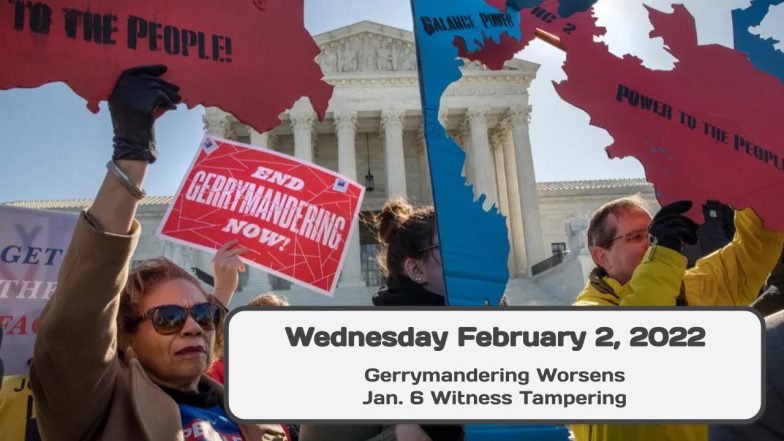News
The Conversation, – January 25, 2022
In a democracy, voters choose their political leaders. In a democracy that permits gerrymandering – when state legislatures draw legislative district lines that maximize the dominant party’s chances of winning seats – elected leaders choose their voters.
Gerrymandering undermines representative government. But it’s nothing new. The term “gerrymander” stretches all the way back to a member of the founding generation: Elbridge Gerry, who as governor of Massachusetts led the effort in the 1810s to rig the state’s legislative districts for the benefit of his fellow Republicans.
Gerry would be astounded to see the tools he’d have at his command in creating a gerrymander today. No longer do legislative line-drawers need to rely on their instincts in creating a district map that will advantage their party’s candidates. Sophisticated computer programs can maximize a party’s advantage by creating districts that can put Gerry’s famous salamander-shaped district to shame.
Redistricting doesn’t directly affect the U.S. Senate, where the 100 senators represent 50 states – two senators per state – whose boundary lines don’t change.
But the Supreme Court has required U.S. House constituencies to be equal in population. Geographic migration requires that most House districts be redrawn after each U.S. Census to keep those constituencies equal in size.
In the great majority of states, whose legislatures hold the power to redraw their legislative districts, this opens the door for the dominant party to redraw district lines to increase their dominance.
And in the latest round of redistricting, the results – so far – have furthered the anti-democratic trend where elected leaders choose their voters, undermining the very principles of representative government.

How to gain advantage
Gerrymandering is done in two ways: packing and cracking.
Packing involves putting as many voters of the opposition party as possible into one – or just a few – legislative districts. That district becomes a safe opposition-party district, won by a massive majority of opposition-party voters, far beyond the 51% majority required for victory. If all those voters were spread around other districts, they would help the opposition win those other districts’ seats. When its voters are packed into one or a few districts, then the opposition party gets a few very safe seats, but the party drawing the lines gets many more very safe seats for itself.
Cracking means dividing areas of opposition strength among several legislative districts so the opposition party is unlikely to win any of them.
Political scientists like me can test for gerrymandering by comparing election results with a state’s “normal” partisanship. We measure “normal” partisanship by examining election results for offices that are not very visible to most voters, so their partisan loyalties usually guide their voting. Another measure of gerrymandering is to compare the total popular vote for a party’s state legislative candidates with the proportion of legislative seats that party wins.
Using either of these measures, we find that gerrymandering put a Republican thumb on the scale in state legislatures and the U.S. House in the 2010s by enabling that party to win more legislative seats and pass more bills than would have happened without gerrymandering.
If Democrats had been able to sweep the 2010 state legislative elections, they likely would have done the same.
In Indiana, for example, Republican candidates for the usually low-visibility offices of Indiana secretary of state and state treasurer received an average of 58% of the Indiana vote from 2010 through 2018, indicating that around 58% of Hoosiers normally vote Republican. But in legislative elections held after the Republican-dominated state legislature redrew district lines in 2011, Republicans won a full 71% of state House seats – and 74% in the state Senate. This clearly suggests gerrymandering.
That was true of the U.S. House as well. In Ohio’s most recent midterm election in 2018, Republican candidates for the U.S. House got 2.3 million popular votes, or 53%, compared with 2.1 million for Democrats.
Yet because of gerrymandering, even in a Democratic wave year, Republicans won 75% of Ohio’s U.S. House seats. Thus, Republicans were able to win a super-majority (three-quarters) of Ohio’s House delegation with only 52% of the popular vote.

Partisan sorting by geography
The recent Republican advantage in gerrymandering isn’t the only reason for the GOP’s current structural advantage in American politics. Geographic clustering makes a difference too.
People who vote Democratic tend to be concentrated in big cities, where large minority populations live. So Democratic U.S. House candidates usually receive large majorities of the vote in urban districts: 70%, 75%, even 80%.
But that’s a wasteful majority. They need only 51% to win those seats.
If the surplus Democratic voters were to move to rural and exurban areas, they would make these areas more competitive for their party. Lifestyle preferences are not easily changed, however.
Gerrymandering distorts more than the election chances of the two parties’ candidates. It affects the policies that state legislatures and Congress pass.
Here’s what those majorities do with their power.
[Like what you’ve read? Want more? Sign up for The Conversation’s daily newsletter.]
When states have heavily Republican-dominated legislatures, those legislatures are likely to pass laws sharply restricting abortion and voting rights, banning mask mandates to deal with the COVID-19 pandemic and permitting the carrying of weapons without permits.
Where Democrats control state legislatures, they have often passed dramatically different policies, including expanded voting and abortion rights.
Fine-tuning the squeezing
After the 2020 Census, the partisan effect of gerrymandering has been more limited. That’s because gerrymanders after the 2010 Census were so effective in squeezing out the maximum number of seats for their party that dominant state legislative parties are now mainly trying to fine-tune their earlier efforts.
But the 2020 gerrymanders have had another pernicious effect. The fine-tuning, intended to shore up the dominant party’s existing areas of strength, means that the number of competitive U.S. House districts has been whittled to a new low – probably less than one in every 20 House seats.
As a result, the number of districts safe for one party has skyrocketed.
In these districts, the elected representative can pay attention to only his or her own party’s activists and identifiers; the other party can be safely ignored. So the U.S. House becomes increasingly divided between undiluted right – or Trumpist – and left wings, neither with any incentive to compromise.
That may be the most consequential effect of all.
Gerrymandering thus becomes yet another way in which the institutional rules of U.S. politics – for instance, equal representation of states in the U.S. Senate regardless of population, the Senate filibuster and the Electoral College – can limit majority rule.
A member of the House panel investigating the January 6 insurrection at the US Capitol said Wednesday that former President Donald Trump is tampering with witnesses by vowing to pardon those involved in the riots if reelected in 2024.
CNN, February 2, 2022 – 10:10 am (ET)
https://www.cnn.com/2022/02/02/politics/pete-aguilar-trump-january-6-pardons-cnntv/index.html
PBS NewsHour, February 2, 2022 – 10:00 am (ET)
PBS NewsHour – February 2, 2022 (07:09)
Lindsey Graham was at the garbage dump this weekend when he got some unsolicited input on his favored Supreme Court nominee: Judge Michelle Childs of the U.S. District Court for South Carolina.
“Three guys in pick-up trucks came up to me and said she ‘seems like a nice lady. I’m tired of this Harvard-Yale stuff.’ The great equalizer is the garbage dump because everybody’s got to throw out garbage,” Graham said in an interview Tuesday. “I was just struck by what they thought.”
The South Carolina senator has often seemed like President Joe Biden’s biggest antagonist over the past couple years, calling for investigations into his son and aligning himself at times with former President Donald Trump’s efforts to overturn the 2020 election. But at this moment, on the critical issue of the upcoming high-court vacancy, Graham might be Biden’s best Republican ally.
Graham is stumping hard for Childs, arguing her public state school education pairs well with Biden’s pledge to nominate a Black woman. He’s the most likely Republican on the Senate Judiciary Committee to align with Democrats on a Supreme Court pick and send the nominee to the Senate floor with bipartisan support. And he’s condemning his party’s idea to try to block Biden’s nominee from moving forward by obstructing a committee vote: “I just don’t think it’s good for the process.”
Those moves have raised the specter that Graham, who once lavished praise on Biden “as good a man as God ever created,” may be making a political shift back to the deal-cutter who worked on immigration reform and defused a brutal Bush-era battle over judges. At a minimum, Graham still seems to believe in deference to presidents on nominations, despite his fury at how Democrats handled the confirmation of Justice Brett Kavanaugh and his swing from vociferous Trump critic to ardent defender.
“Lindsey Graham prides himself on independence and unpredictability,” said Senate Judiciary Chair Dick Durbin (D-Ill.). “That, I think, is what you’re seeing.”
Graham said he “absolutely” still considers Biden a friend, but an actual thaw may be a ways off — if it ever comes at all. The two haven’t talked since Biden became president, Graham said. The White House did not respond to a request for comment.
“I’ve been critical of his performance because I think it’s been bad for the country, bad for the world. I’ve got a job to do. You’ve got to be able to compartmentalize up here,” Graham said of Biden. “My job up here is to push back on the radicalization of the country. And if you can find common ground do it.”
Graham’s potential vote for Childs or another nominee may turn out vital: Sen. Ben Ray Luj´an (D-N.M.) had a stroke last week, a reminder that Democrats’ 50-seat majority is tenuous and could always use some padding in the form of Republican votes. And it’s safe to say Democrats are intrigued by Graham’s sudden burst of positivity about filling a Supreme Court seat for Biden.
“Sen. Graham has a long history of supporting qualified [nominees], before the last few years where nominations have become divisive, partisan and bitter events,” said Sen. Chris Coons (D-Del.), a frequent collaborator with Graham. “I’m hopeful that Sen. Graham is simply hoping to continue what was a long tradition of supporting qualified nominees.”
Over his 19 years as a senator, Graham has remained consistent on judges, voting to confirm seven of the nine Supreme Court justices, including Democrat-nominated Justices Elena Kagan and Sonia Sotomayor. That shifted in 2016, when Graham supported the GOP’s blockade of former President Barack Obama’s Supreme Court nominee Merrick Garland.
Two years later, Graham warned in a fiery speech that Kavanaugh’s treatment by committee Democrats would “destroy” the ability to attract good nominees and said of Democrats: “Boy, y’all want power. God, I hope you never get it.” Then, as Judiciary chair, Graham pushed through Justice Amy Coney Barrett’s nomination days before the 2020 election.
After moderate Sens. Susan Collins (R-Maine) and Lisa Murkowski (R-Alaska), Graham is the third-most supportive GOP senator of Biden’s judicial nominees over the past year. Graham and Collins are the only senators left from the Gang of 14, which temporarily defused a fight over killing the judicial filibuster in 2005.
Moreover, Graham’s vote on the Judiciary Committee carries serious weight: If he joins Democrats, he allows nominees to get reported directly to the floor, avoiding cumbersome procedural votes triggered by a tie-in committee. He also gives them a bipartisan imprimatur.
“Sen. Graham is of the mind that if you win the presidency you’re entitled to your nominees, absent some exceptional circumstance,” said Sen. John Cornyn (R-Texas), a Judiciary Committee member. “So he’s been a pretty routine vote for any Democratic president’s judicial nominees.”
It’s not just judges: Graham also supported Biden’s infrastructure plan, drawing condemnations from some conservatives in South Carolina. He also famously helped negotiate the Gang of Eight bipartisan immigration bill in 2013, while fending off primary challenges back home. As he considers a Supreme Court nominee from a Democratic president he counts as a friend, he has even less to worry about back home: He just won reelection to a six-year term in 2020.
Though Biden is considering several Black women as a nominee, Graham is fairly single-minded on Childs. He called her “the kind of person I think I could support” and predicted that her profile could “do well with Republicans.” Childs was confirmed by voice vote in 2010 as a District Court judge, the type of ho-hum confirmation that basically never happens anymore.
Rep. Jim Clyburn (D-S.C.), No. 3 in House Democratic leadership and a longtime ally of Biden’s, also called on the president to select Childs. And though not as effusive as his fellow South Carolina senator, Republican Tim Scott had kind words for her: “She is a strong candidate. And she’s proven herself across South Carolina as a state judge and now as a federal judge. She continues to receive praise on her approach.”
Graham also voted for Ketanji Brown Jackson — another woman considered a frontrunner for the nomination — to be a judge on the U.S. Circuit Court of Appeals for D.C., along with Collins and Murkowksi, but seemed less enthused with her as Supreme Court material, at least for the moment.
“I’ll cross that bridge when we get there,” he said. “I’m pretty firm on what we should be doing.”
Graham’s more pragmatic side may have put him back on the outs with Trump. The former president referred to Graham as a RINO, or Republican in name only, during a Newsmax interview Tuesday night over Graham’s comments that those accused of attacking the Capitol on Jan. 6 should not be pardoned.
Asked Tuesday morning if Trump would be angered by Graham’s work on a potential Biden nominee, Graham replied: “I doubt it.”
CNN, – February 2, 2022
President Joe Biden has formally approved additional US military deployments to eastern Europe, and the Pentagon is expected to announce Wednesday morning that the troops will deploy “in the coming days,” US officials told CNN.
The deployments are a show of support to NATO allies feeling threatened by Russia’s military moves near Ukraine, the officials said.
The Pentagon is expected to announce that thousands of additional US troops will deploy to forward locations in Europe. The deployments will include roughly 2,000 US troops to Poland and an additional few thousand to southeastern NATO countries, including Romania, the sources said.
The US has put 8,500 troops in the US on heightened alert in case a NATO Response Force is called up and US forces are needed quickly. But the US and NATO have tens of thousands of other troops already in Europe to draw on for any additional deployments to Eastern European allies; some of the troops that will be deployed soon are already stationed in Europe, the sources said, while others will come from those in the US that are already on heightened alert.
The troops will operate on a bilateral basis with their host countries, since NATO has not yet activated a multinational response force.
CNN reported last week that the US and a handful of allies had been in discussions to deploy thousands more troops to Eastern European NATO countries before any potential Russian invasion of Ukraine as a show of support in the face of Moscow’s ongoing aggression.
Biden also said last Friday that he would be moving the forces “in the near term,” as Russia has continued to build up forces near Ukraine, sparking fears of a renewed invasion even as diplomatic efforts to de-escalate tensions have continued.
Leading Democrats, many academics, liberal commentators, and left-leaning activists agree: American democracy is in grave peril. It’s besieged on all sides, the threats culminating so far in Donald Trump’s attempt to steal the 2020 presidential election from Joe Biden. More tumult likely lies ahead.
But there’s a surprising amount of murkiness about what, exactly, this peril entails — and what can and should be done about it.
Several dark scenarios for the future have been posed, but each is quite different. One is the threat of a stolen election — Republicans could outright steal elections Democrats won, as Trump tried to do, perhaps enhanced by mob violence. Another is the minority rule threat, in which Republicans could consistently win according to the rules but without getting a majority of votes nationwide, due to advantages in the Senate, Electoral College, and redistricting.
PBS NewsHour – January 28, 2022 (00:23)

